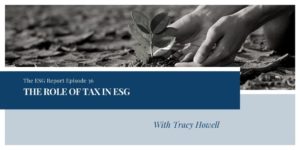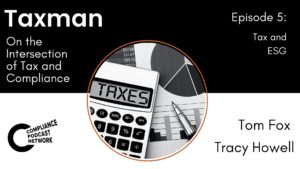What is the intersection of tax and compliance? Why does a Chief Compliance Officer (CCO) or compliance professional need to sit down with the corporate head of tax? How does a corporate tax function fit into a best practices compliance program? It turns out there is quite a bit a compliance professional can learn from a tax professional. Moreover, there are many aspects of tax which should be considered by a CCO and compliance professional from an overall risk management perspective. Unfortunately, these questions are rarely explored in the compliance community.
To explore these issues (and remedy this lack of awareness) I recently sat down with noted tax professional Tracy Howell to explore these and other questions. We tackled these issues and others in a five-part podcast series for Innovation in Compliance. Today, in this concluding blog post, we consider the role of tax and Environmental, Social and Corporate Governance (ESG).
We began from where Howell sees ESG from a tax perspective. ESG is the acronym for and covers environmental, social, and governance sections of an entity. For the ‘E’, environmental, an organization is supposed to be monitoring and contributing to its social requirements of its environmental footprint. It can include such areas as wastewater management, energy efficiency, carbon footprint of an organization. In the ‘S’ or social component, it includes the human rights, where an organization is operating, its Human Resource (HR) function, the wellbeing of its workforce, fair wages and much more. In the ‘G’ or governance, it includes the executive compensation, which Howell noted is “a high-profile item”, political contributions of an entity, board independence and composition, the demographics of its executives, whistleblower schemes, among many others.
Importantly, Howell believes there are “external forces pulling tax into the S and the G of the ESG component.” From the social component, how does tax fit in? The phrase “being thrown around these days is for companies to pay a fair share.” Yet in addition to that being an arbitrary term for multinationals, Howell believes it is “really misunderstood because there are different countries or jurisdictions which have different tax rates. Some are higher, some are lower.” This means that as companies employ a tax strategy “to operate in a most tax-efficient manner, their activities are going to gravitate to lower tax regimes. Social taxes becoming more common in social piece of ESG, and you’ve got forces trying to push the concept of fair share rather than just compliance with the tax laws of those different jurisdictions.”
There is also a tax component in the governance prong. It is becoming more common for companies to have to talk about their compliance tax audits. Howell emphasized this “does not mean a company has a perception of not being compliant in governance simply because a company’s following the laws of the different jurisdictions.” Additionally, Howell has seen litigation in the European Union (EU) between the “countries where there is some intellectual property licensing and one jurisdiction that’s at a lower rate, and governments are giving maybe some tax concessions to draw business incentives.” Subsequently those are being challenged, so that too falls under the ‘G’ for governance.
Howell believes the continued pressures on ESG transparency are growing. This could well lead to standardized reporting and score carding of entities on their tax transparency. US publicly traded companies currently have substantial reporting requirements in material areas of their operations and income taxes, which is “one of the large footnotes as required in SEC reporting.” Indeed, some international organizations such as the Organization for Economic Cooperation and Development (OECD), the International Financial Reporting Standards Foundation (IFSR), the World Economic Forum, and the Sustainability Accounting Standards Board (SASB), “are all drafting up their own and pushing out their own transparency scorecard that would include some things like effective tax rates.”
Another key issue Howell sees in the conjunction of tax and ESG is in the arena of effective tax rates (ETR) reporting by jurisdiction. In ETR “if you are in a high-tax country such as the US and then your organization has operations in Ireland, which has a lower income tax rate; if you just put those on paper and compare the two effective tax rates without an explanation or thorough understanding, you’re going to get an inaccurate conclusion. But these organizations are pushing for globalization and transparency, and it’s going to be a component for ESG score carding.” All of this will mean more importance for tax in an overall corporate ESG program.
We concluded with what Howell sees as the most important reason for tax to be a part of a company’s ESG discussion. That reason is the market. Howell stated the “biggest pressure that’s coming on top of multinational organizations around ESG is coming from the institutional investors. Large institutional investors play a heavy role in impacting a multinational’s activities. Every CFO really has to listen to the institutional investors that he has or his entity have relationships with. Moreover, institutional investors are probably the biggest 500-pound gorilla in the room that are making investment decisions with their millions of dollars, and they are incorporating an ESG scorecard with tax transparency. It is a big part of where they are making their investment decisions. So, the biggest players in the room that are asking for tax transparency are institutional investors, the pension funds and investor class. Those investment dollars are driving the CFOs and organizations to get ahead of SEC reporting and requirements and include an ESG scorecard component, of which tax is going to be a large component.”
What started off as a discussion of regulatory and legal requirements around tax has become market driven. This echoes my observation that it was not government regulation which drove ESG but the market. As antithetical as the former administration was to ESG, the market spoke about what it wanted for its investment dollars. This speaks to the overall and what will be the long-lasting power of ESG.
Check out the full podcast series Taxman: On the Intersection of Tax and Compliance on the Compliance Podcast Network. Check out Tracy Howell on LinkedIn.










